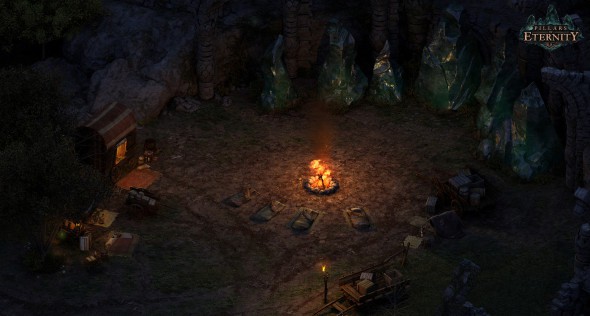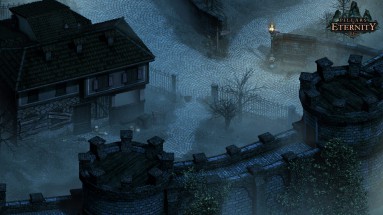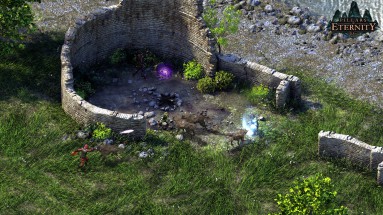Platforms PC/OS X/Linux
Developer Obsidian Entertainment Publisher Paradox Interactive
Genre RPG Platform Played On PC
From the richly-detailed books talking about cities, history, races and so on, to whole backgrounds and personalities created for characters you meet along your journey, it’s pretty obvious just how much passion and love went in the creation of Pillars of Eternity. Seeing how popular – and profitable! – its Kickstarter campaign was, it’s also clear this is just the beginning of a new intellectual property. Hell, an expansion is already on its way. But, let’s not get ahead of ourselves. Simply put, Pillars of Eternity is a love letter to old-school gamers – particularly to fans of role-playing games – and an accessible title to a newer audience to said genre.
Pillars of Eternity features four, basic difficulty settings – Easy, Normal, Hard, and Path of the Damned (this one including enhanced enemies, both in number and statistics) – in addition to Expert Mode which disables helping tips throughout your adventures, and Trial of Iron which is basically a permanent-death mode. For my first play-through, I always choose the most basic type of adventure, so I simply check the Normal option.
This being a RPG, before the actual gameplay, players choose from a variety of statistics when creating their character, ranging from sex, race and class, to culture, appearance and voice. Races here include the usual Human, Elf and Dwarf, in addition to Pillars of Eternity-specific ones, such as Aumaua, Orlan and Godlike, each coming with its own general background and starting bonuses.
When it comes to classes, Obsidian Entertainment’s latest impresses with 11 types, ranging from the usual Fighter, Ranger and Wizard, to other classes which deviate from the norm with their specific bonuses and traits, such as the Chanter, Monk and Cipher. There are even classes which combine basic ones, such as the Druid, which focuses on melee attacks via spirit-shifting and ranged attacks via spells. Moving on, choosing a culture and personal background affects your character’s initial appearance, a few statistics, and even their weapon. For example, my first character’s initial weapon would change from one kind of bow to a different crossbow, depending on what part of the world I would decide to come from.
While nothing on the scale of Dragon Age (not Dragon Age II, mind you) or Skyrim, Pillars of Eternity‘s overall customisation options are robust enough, offering quite a lot of insight into each of its race, class, and culture. I think I’ve spent almost two hours reading everything there is and choosing between each of them, something which I rarely do.
Looking for a fresh start, my character – a female Elf called Mira – and her wolf companion Lars (said animal ally being available only to the Ranger class) decide to travel to a village called Gilded Vale, where one lord Raedric apparently offers “land and wealth.” Of course, things don’t go as planned, and a mysterious ill befalls Mira. What’s worse, while searching for a cure, a windstorm passes by, forcing Mira, Lars and two other companions to retreat to a nearby cave. After exploring a bit, you and your party discover a strange machine on the other end of the cave. Suddenly, you are knocked unconscious, and when you wake up, everyone is dead, except for Lars. After a while, Mira learns that she’s what people call a Watcher, someone who’s able to see into the past of those long gone.
It is through this power of sorts that chapters from other people’s lives start unfolding, ranging from stories of witches being accused of the Gilded Vale’s curse to a man being killed in broad daylight by what appeared to be a friend of his, to even bleaker ones like putting animal souls into children, thus transforming them into monsters. There are quite a lot of these “mini” stories waiting to be read, which don’t seem to have any relation with the overall plot, although the expertly crafted writing makes them that much more interesting. To take further advantage of this feature, the developer has also added murder mysteries, which can be solved by interacting with the dead, as the living tend to have this nagging desire of lying.
The game is very text-heavy, so patience is highly recommended; otherwise, it might not be the RPG you’re looking for. What you need to understand here is the fact that playing Pillars of Eternity is essentially like reading a book instead of watching its respective film. It doesn’t feature fancy graphics, cut-scenes – these being somehow replaced by pen-and-ink illustrated storyboards – or anything in-between. The writing does pretty much everything, narrating what would have been a cut-scene, gesture of a character, and so on. Old school gamers will definitely enjoy it. Right from the get-go, it oozes with that Baldur’s Gate atmosphere.
When levelling up, your character can be improved through five skills: Stealth, Athletics – which reduces the fatigue penalties and helps intimidating others during conversations – Lore, Mechanics – which improves your detection of traps and allows you to craft them – and Survival; more points here means food and potions will have a longer effect. Not only that, but players can also choose a new talent for their character, which range from class-specific and offensive sets, to defensive and utility. What I really appreciate here is the fact that, while the overall text-heavy nature of the game might look intimidating to the usual gamer, the rest of Pillars of Eternity is accessible and not even that complex. It strikes the perfect balance between old and new; although the Infinity Engine is definitely aimed towards old school fans.
Not to say that it’s primary gameplay, the combat, isn’t challenging. There’s a reason why an entire menu is dedicated to different options of pausing before each encounter, as it’s crucial to plan your every strike, spell, and positioning, because there’s no friendly fire. For example, in one of the game’s first dungeons, I encountered about four spiders. I thought “pffft, no need to pause; it’ll be a piece of cake.” Got my whole party killed. As it turns out, though, pausing and selecting appropriate spells/attacks and their respective targets turned the entire affair in my favour, ending the fight in less than ten seconds. Hell, sometimes, it’s better to pick them one by one, instead of trying to bite more than you can chew.
Fully restoring your abilities and health can be done by setting up camps wherever you want. That said, you’ll first need camping supplies to do so. Alternatively, you could sleep in an inn for the same effect, although more expensive rooms provide a broader set of bonuses. More than that, it’s important to rest at one such camp from time to time, because your characters progressively get fatigued, getting minor penalties at first – like lowering a character’s accuracy – but growing in severity over time.
Scouting – a.k.a. moving stealthily – can reveal traps, in addition to sneaking up on enemies and allowing you to steal from others, without any consequences; well, as long as they don’t see you. Speaking of consequences, your reputation also affects your journey. For example, helping someone from a specific community or faction means these people will reward you. Of course, doing anything from the opposite side – like stealing – results in a negative perception. It’s even possible to have both a positive and a negative reputation with a single group.
After a while, my party grows stronger with the addition of a wizard. As such, I’ve noticed that, in Pillars of Eternity, wizards can learn a great number of spells, although only four can be added to a grimoire and used at a time. Players can, of course, edit one such book of spells however they want, in addition to purchasing or stealing from enemies up to ten, in total. On the other hand, priests aren’t restricted to these grimoires, although they can’t cast said spells as often as wizards. Naturally, there are a lot of spells wizards and priests can learn, ranging from the usual fireballs to creating duplicates of their allies to distract enemies.
Your chosen race and class aren’t just for show, either, as certain dialog options are available to certain classes and backgrounds, only. It seems like there aren’t any right or wrong answers, so whatever you chose, it’s going to solve any situation, one way or another. Persuading others to your own resolution is achievable either by reasoning with them via knowledge and trivia of occult and esoteric topics – i.e. investing experience points into Lore – by intimidation – i.e. investing XP points into Athletics – or by cunning.
Because Pillars of Eternity is a party-based RPG, visiting a local inn gives you the ability of recruiting others to your cause, some even starting from level two and above. As soon as you’ve paid up, you are given the chance to customise another character, exactly the way you did for the original. When a party member dies, he/she will still recover, as long as at least one member survives whatever encounter they’re currently facing. That said, the fallen one’s health doesn’t fully regenerate.
Pillars of Eternity looks great from a distance, although zooming all the way down reveals a jarring difference between the pre-rendered, two dimensional environments and the three dimensional characters. It’s rather odd that not every character in the game is voiced, though. That wouldn’t be such a problem if those that do feature voice-work would actually speak every line. I’m not sure if that is a bug or a design decision; in any case, it’s weird. Pillars of Eternity also features a real-time day-and-night cycle, this being most apparent when eight hours have passed due to sleeping at an inn or camp.
There are even multiple ways of completing specific objectives. I won’t spoil much, but just to give an idea, meeting with a certain lord can be done either by killing everyone in your way, sneaking, or by striking a bargain with someone else, if you carefully choose your words. Not only that, but certain situations require the force of a brute – e.g. a Barbarian – while others, more finesse. For example, infiltrating a castle can be done in three ways. One could either bend a few bars with their immense strength and get inside via the sewers; sneak up atop a wall via some vines; or simply slaughter everyone via the main gate.
Getting knocked out a second time before resting means you or another companion of yours will permanently die, also meaning it’s either “game over,” or you won’t be able to complete quests related to said companion. Because of this, it’s also important the way you arrange your formation. Naturally, the best idea is to put Fighters and Barbarians at the front, while Rangers and spell casters, in the back.
After a while, I encounter another type of magic user, this time, a chanter. What separates this class from wizards or monks is the fact that they arrange all of their spells as strings of magical phrases. Because of this, you won’t even have to control them in battles, as they cast the spells, one after another. All you have to do is edit one such string, just as you do with the wizards’ grimoires.
It has taken me about 15 hours, but I have managed to find Pillars of Eternity‘s own safe-house. Well, safe-stronghold. As it turns out, players can upgrade said fortress to its former glory, akin to, let’s say, Ezio upgrading his Villa in Assassin’s Creed II. To make matters more realistic, every upgrade needs time in order to be finished, time ranging from two to four days. The stronghold can be improved in many aspects, ranging from its main keep, walls and towers, to barracks, dungeons, shops and many other buildings.
As I’ve mentioned above, Pillars of Eternity doesn’t look as good when zooming all the way down. Still, this unfortunate issue is completely overshadowed by a great variety of environments, which range from the usual forests and villages, to castles, beaches, spider-infested dungeons and the two, huge cities.
After meeting another Watcher, Mira realises that she’s in grave danger of losing her mind, due to being in constant contact with spirits from other lives, so she decides to find a way of undoing this process which has made her a Watcher. As with any other RPG on the scale of Pillars of Eternity, it’s the small, well-written stories that encompass the bigger plot, although said plot about fallen Gods and mankind’s response is actually quite engrossing, something which few games from said genre offer. Mysteries and plot-twits abound, and your fellow companions only sweeten the deal, ranging from the tried-and-tested smart-ass Fighter (think Dragon Age‘s Alistair) to the almost-mad Priest or mysterious Wizard, whom you don’t really “get” until further in, when his own quest reveals itself.
When it comes to RPG’s, I’m more often than not used to playing as the “lone wolf” type. Sure, I can tolerate one party member or two, but that’s only because I like their comments on current events which I’m dealing with (the perfect example being Mass Effect or Dragon Age). Still, Obsidian Entertainment’s Pillars of Eternity is so good, that it has managed to “convert” me to this party-based style of play. Sure, the most obvious reason is the fact that I couldn’t possibly win battles with Lars alone, but absolutely everything else also contributed to further reel me in. The quests are varied, characters are a joy to interact with, combat is challenging – even on the Easy/Normal difficulty – and the Infinity Engine is a sight to behold; well, old-school fans like me will definitely appreciate it more than newcomers, but it still looks good. I honestly can’t think of one, single flaw that would even remotely deter from the experience. The Witcher 3 has yet to arrive, but even so, you can safely bet Pillars of Eternity will give a run for its money, when it’ll come to the Best RPG of the Year award.
The Good
- Robust Customisation Options When Creating Your Character
- Expertly Written
- Deep Lore and Mechanics
- Challenging Combat
- Looks Great… from a Distance









